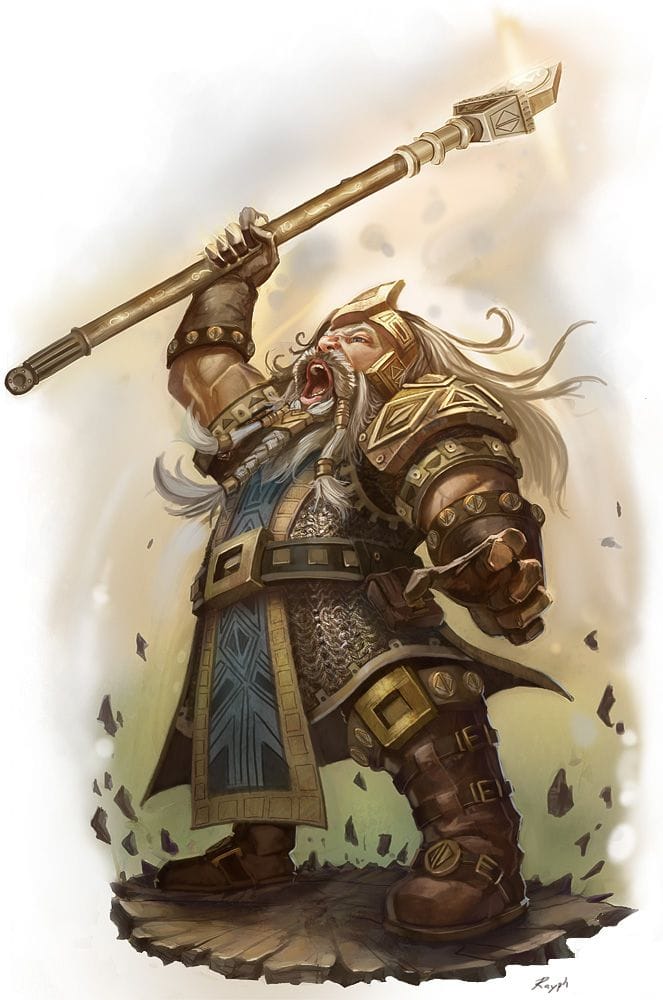Dwarves were part of Western folklore long before the advent of The Lord of the Rings and Dungeons & Dragons. From the Brothers Grimm back to Norse Mythology, stories of little people with tools were in the human psyche.
J. R. R. Tolkien took these fairy tale creatures and depicte them as warriors with characters like Thorin and Gimli. The short and stocky badass was a new archetype for action fantasy readers.
Dwarves are a D&D Race that may seem like David vs Goliath figures, but something else is going on. While David would show great courage in overcoming his fear of facing Goliath, Gimli wouldn’t need courage because he would have no fear.
Dwarves like Gimli don’t view their enemies as something to fear. When Gimli faced overwhelming odds at the Battle of Helm’s Deep, he made with his elven comrade over who could kill the most orcs instead of overcoming his fear.

What Dungeons & Dragons has done is gamify this short badass archetype. Over the years, this archetype has expanded into many variants, short badasses that do magic, short badasses that are evil, short badasses that are Barbarians, Paladins, etc. Let’s begin our Dwarf 5e Guide by looking at Dwarf’s traits.
Dwarf Traits
All Dwarves belong to one of the various subraces, which will be discussed below. Your ability score increase (ASI) will depend on the dwarf subrace you choose to play.
However, all of the subraces will have 1 ASI of +2 on Constitution because all dwarves tend to be tough. Most of the subraces will have the following traits in common regarding player characters:
- ASI: +2 CON
- Age: 50-350 years
- Size: 4-5 ft, 150 lbs.
- Speed: 25 ft/turn and no speed penalty for heavy armor
- Darkvision: 60 ft
- Poison: Advantage on poison saving throws and resistance to poison damage
- Weapon Proficiency: battleaxe, handaxe, light hammer, warhammer
- Tool Proficiency: 1 artisan tool from- smith’s/brewer’s/mason’s
- Stonecunning: History check for stone, 2x, auto pro
- Languages: Common and Dwarvish
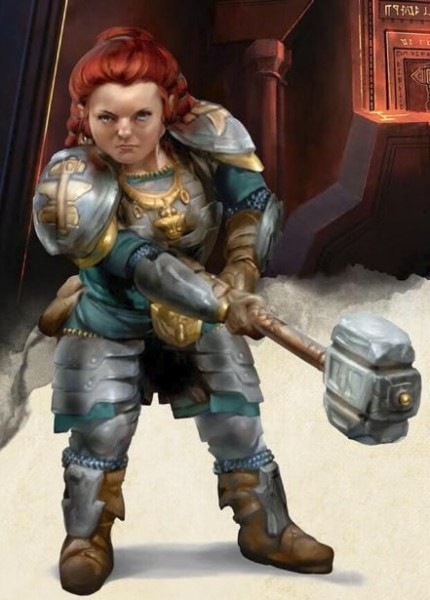
Regarding Darkvision, it doesn’t mean that they have perfect vision in complete darkness within that range. They can see in dim light as if it were normal light and in darkness as if it were dim light.
Age 50-300 years means that dwarves reach adulthood at 50 and have an average lifespan of 300 years.
Dwarf Subraces
In the Player’s Handbook (PHB), two subraces appear. Duergar are mentioned, but their stats do not appear PHB. Their stats do, however, appear in the Sword Coast Adventurer’s Guide (SCAG)
| Subrace | ASI 1 | ASI 2 | Darkvision | Racial capability |
| Hill | +2 CON | +1 WIS | 60 feet | +1/HD for HP |
| Mountain | +2 CON | +2 STR | 60 feet | Light and Medium armor |
| Duergar | +2 CON | +1 STR | 120 feet | Enlarge 3rd Lvl, Invisibility 5th Lvl |
The ASIs and Darkvision are self-explanatory. Regarding racial capabilities:
- Hill dwarf player characters gain one 1 hit point on each hit die per level. I.e., a 1st level hill dwarf cleric with a 16 Constitution would have 1d8 hit points for their level +3 hit points for constitution +1 more for this racial capability for a total of up to 12 hit points.
- Mountain dwarf player characters automatically have proficiency in all light and medium armor.
- Duergar dwarf player characters gain the innate magical ability to cast Enlarge Spell when they reach 3rd level and Invisibility Spell when they reach 5th
Mountain dwarves tend to fit the image of the dwarves from The Lord of the Rings. Hill dwarves are similar to mountain dwarves but are more intuitive and have keener senses.
While all dwarves are comfortable underground, Duergar like to live in deep underground places like The Underdark of the Faerun world. Duergar, also called gray dwarves, because of their skin tone, are usually evil.
See also: Duergar 5e Guide.
Half-Dwarves
In the D&D world, whenever I’m asked about a “half anything,” my first question is, “What is the other half?” We usually assume half-elf and half-human, half-orc and half-human, etc., but in the D&D world, anything is possible.
Let’s start with half-dwarf/half-human. Here are some basic guideline stats for those who don’t want to homebrew:
- ASIs: CON +2, +1 in 2 other abilities of player’s choice
- Age: 30-200
- Size: 4 ½ ft-5 ft tall, 150-250 lbs. weight
- Speed: 25 ft but not reduced by wearing heavy armor
- Darkvision: 60 ft
- Dwarven Resilience:
- Proficiencies: 2 skills proficiencies and 1 tool proficiency of player’s choice
- Languages: Dwarvish and common
Half-dwarves do not appear in PHB. The stats above could, of course, vary depending on the dwarf subrace. A Duergar/human half-breed might have some innate magic ability.
Their outlook tends to resemble that of half-elves in that they are caught between two worlds, not dwarf enough for the dwarves and not human enough for humans. That makes the life of an adventurer attractive to them.
Dwelf: Besides dwarf-human, another popular half-dwarf combination is dwarf-elf. Since the Gimli-Galadriel extramarital romance alluded to in The Lord of the Rings, the offspring of dwarf-elf unions has become so common that they even have their own name, dwelves.
Dwelf traits: (not to be confused with a hairless cat)
- ASIs: CON or DEX +2, INT +1
- Size: Taller than dwarves and shorter than elves
- Speed: 25 ft
- Darkvision: 60 ft
- Racial prejudice: disadvantage on Charisma checks with dwarves and elves (see below)
- Fey Ancestry: same as elves
- Dwarven Resilience: same as dwarves
- Innate Magic: Any 1 wizard cantrip cast with INT modifier
- Weapon Proficiencies: shortsword, shortbow, handaxe, and light hammer
- Languages: Common, Dwarvish, and Elven
Throughout many D&D worlds, there have been tension between elven and dwarvish communities and that was also the case in Tolkien’s Middle Earth. Naturally, the offspring between two races that are already having bad relations is going to difficulties far beyond their half-dwarf/half-human counterparts.
Dwomes and Other Possibilities: With three subraces of dwarves in PHB and 3 subraces of elves listed in PHB, the possibilities of half-dwarves and dwelves are broad indeed.
When you factor in other demi-humans like halflings and gnomes the possibilities only increase. The pool expands further when adding orcs, goblins, centaurs, etc. Then there are the planetouched, like tieflings and genasi…
Dwarf Character Build
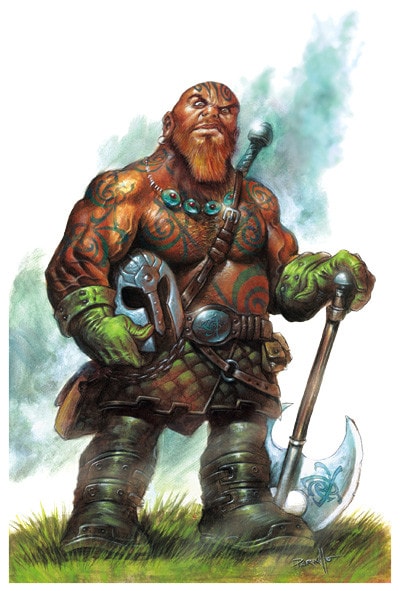
When you factor in all three subraces of dwarves, there are a lot of great character builds:
Hill dwarf cleric, Mountain Dwarf Barbarian, Duergar Fighter, etc. I’m picking one my readers might not have considered. I’m going to build a male Mountain Dwarf wizard, and I’ll name him Morgran.
Mountain Dwarf Wizard
For the benefit of readers who are not natural dice-throwers, I’m basing my character-build decisions on the standard scores model PHB, p 13. The standard scores can be moved around into any sequence. Here is the standard sequence in descending order: 15, 14, 13, 12, 10, 8.
| Ability | Strength | Intelligence | Wisdom | Dexterity | Constitution | Charisma |
| Standard Sequence | 15 | 14 | 13 | 12 | 10 | 8 |
| Customized Sequence | 13 | 15 | 10 | 12 | 14 | 8 |
| Racial ASI | +2 | +2 | ||||
| Ability Scores Total | 15 | 15 | 10 | 12 | 16 | 8 |
| Ability Modifiers | +2 | +2 | +1 | +2 | -1 |
If you look at the table above, it seems like some strange stats for a wizard, but mountain dwarves are a different kind of wizard. In my opinion, the mountain dwarf wizard is the best wizard build in the game, at least as far as PHB at the lower levels is concerned. You’ll see why.
Intelligence is a wizard’s primary ability. While 15 may not be the highest Intelligence score for a wizard, it is good enough for a 1st level wizard. At 4th level, I’ll be allowed to add a point and bring it up to 16.
Many would argue that the best secondary abilities for wizards would be Constitution and Dexterity. This is because wizards and sorcerers are the most vulnerable classes in the game at 1d6 hit points per level and have no armor or shield proficiencies.
Wizards are not expected to be frontline fighters, but if the party gets ambushed or severely outnumbered, the frontline fighters might not be able to protect the party wizard, and then the wizard could be the first to get killed.
Because Morgran is a 1st level wizard with 16 Constitution, his 6 hit points become 9. That will make him about as tough as the average bard or rogue and significantly tougher than the average wizard.
Most wizards opt to have some kind of Dexterity because they have no armor proficiency. Morgran, with his 12 Dexterity, is no exception. Without armor, armor class (AC) will be 11.
Most wizards use Strength as their primary dump stat, and wizard with 8 Strength is not uncommon. Morgran is going different. While Morgran does not intend to be primarily a frontline fighter, his 15 Strength should help protect him if an orc or two get past his spells.
His primary dump stat will be Charisma, 8, and Wisdom 10. An ugly or unsociable dwarf is not that usual. Try walking onto a college campus to those who think an intelligent character without much wisdom is an unlikely combination. You’re bound to find plenty of clever people that are not wise.
Mountain Dwarf Wizard: Skill Proficiencies and Tool Proficiencies
As a dwarf, Morgran gets 1 tool proficiency and Stonecunning. As a wizard, he gets 2 skills proficiencies. Furthermore, Morgran will get proficiencies from the background he chooses. Although it’s very unusual for a wizard, Morgran will pick the soldier background.
For this table, I won’t calculate weapon and armor proficiencies.
| Proficiency | Source | Type | Ability | Total Modifier |
| Smith’s tools | Race | Tool | Strength | +4 |
| Stonecunning | Race | Skill | Intelligence | +6 |
| Arcana | Class | Skill | Intelligence | +4 |
| Investigation | Class | Skill | Intelligence | +4 |
| Athletics | Background | Skill | Strength | +4 |
| Intimidation | Background | Skill | Strength | +4 |
| Gaming | Background | Tool | Intelligence | +4 |
| Vehicles (land) | Background | Tool | Dexterity | +3 |
Regarding Intimidation, I would ask my DM if I could make Strength, not Charisma, the modifier. If the DM says no, my modifier would be +1.
Mountain Dwarf Wizard: Armor and Weapons
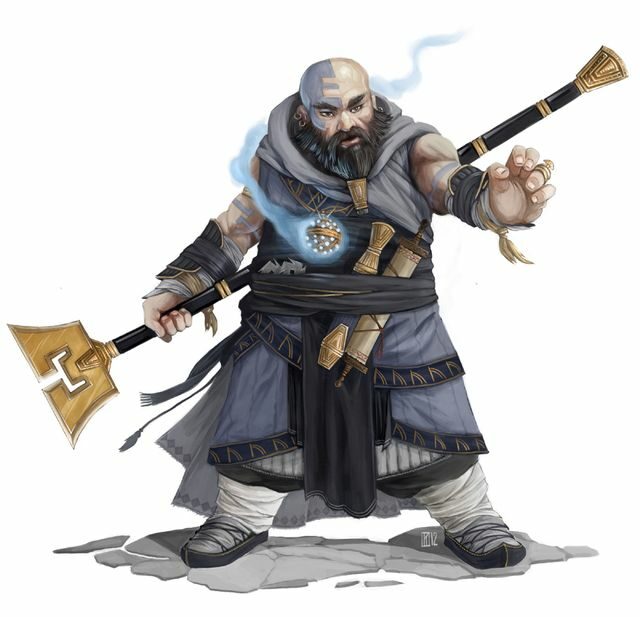
PHB page 201 discusses spell-casting in armor. It states that unless your character is proficient in the armor they are wearing, your character can’t cast spells within that armor. Wizards don’t get an armor proficiency for their class. Therefore, they can’t cast spells in armor. Correct?
Wrong.
Morgran doesn’t have armor proficiency from his wizard class. However, he does have armor proficiency, light, and medium armor, from his mountain dwarf race. There is nothing in PHB that says that Morgran, as a wizard, can’t cast spells in armor that he is proficient in.
Characters with a Dexterity modifier of +3 or more might opt for light armor because medium armor cancels out any modifiers that go past +2. Morgran doesn’t have that issue because his Dexterity modifier is only +1, and all medium armor allows for a Dexterity modifier of up to +2.
He also doesn’t have to worry about heavy and medium armor affecting his movement. As a mountain dwarf or any dwarf, Morgran has the racial trait of not having his movement slowed by armor.
The best non-magical armor in the game is plate armor. If Morgran wore plate armor, his armor basic armor class (AC) would be 18. Adding his Dexterity modifier would make his AC 19. If Morgran were to employ a shield, his AC would be 21, making him very hard to hit for most low-level enemies.
Unfortunately for Morgran, his racial trait doesn’t give him proficiency in heavy armor or shields. That means that medium armor is his best option.
The best non-magical medium armor in the game is half plate armor. That would make Morgran’s basic AC 15 and his Dexterity +1 modifier would move his AC to 16.
Unfortunately for Morgran, as a 1st level character who hasn’t done any adventuring, he can’t acquire the 750 gold pieces (GP) needed to purchase a set of half-plate armor.
A lot of 1st level characters do, however, have the option of starting out with chain mail (heavy armor) or scale mail (medium armor). Scale mail would bring Morgran’s AC to 14, 15 when you add his Dexterity modifier.
If my DM is lenient, I would ask permission to go on a couple of side adventurers before the main adventure starts for the purpose of acquiring extra funding for my wizard so he could at least have scale mail armor. What’s the point of having such a cool dwarven wizard build if you can’t wear the same armor as fighters and clerics, right?
If my DM didn’t allow this, I would take the 10 gp’s from my soldier background and go to the local armorer or tanner to buy a dwarf-sized suit of hide armor. That would give me an AC of 12, 13 with my Dexterity modifier.

If I’m part of a good 1st level party, I would only be 1 or 2 victories away from taking 50 gp worth of treasure from some dead monsters. Then I would petition the party for a “trip into town” so I could upgrade my armor. If the DM complained that this was interrupting his gameflow, my response would be,
“Well, DM, I guess you should have granted me that side adventure I was asking for.”
The same could be said of weapons. If money weren’t an option, my first choice for Morgran would be a battleaxe, which, as a dwarf, he is proficient in.
With a battleaxe, Morgan could add his proficiency bonus plus his Strength modifier. This would give him +4 on attack rolls and +2 on damage rolls. When using his battleaxe with both hands, he would roll 1d10 for damage, putting his total at 3-12 points per turn. That’s not bad for a wizard doing melee without magic!
If due to financial difficulties, Morgran can’t, after spending his life savings on armor, come up with an extra 10 GP to buy a battleaxe, Morgran can opt for the free quarterstaff provided for wizards.
Even though dwarves are not automatically proficient in the quarterstaff, wizards are. That means that when using his quarterstaff with both hands, he would roll 1d8 and have a modifier of +4/+2 for attack and damage rolls respectively. That would put his damage total at 3-10 per turn every time he hits.
| Budget | Armor | Weapon | AC | Dam/turn |
| Low | Hide | Quarterstaff | 13 | 3-10 |
| Medium | Scale mail | Battleaxe | 15 | 3-12 |
As far as ranged weapons, that would also depend on budget as well, but with the right combat cantrip, Morgran won’t need to purchase a ranged weapon.
Mountain Dwarf Wizard: Spells and Cantrips
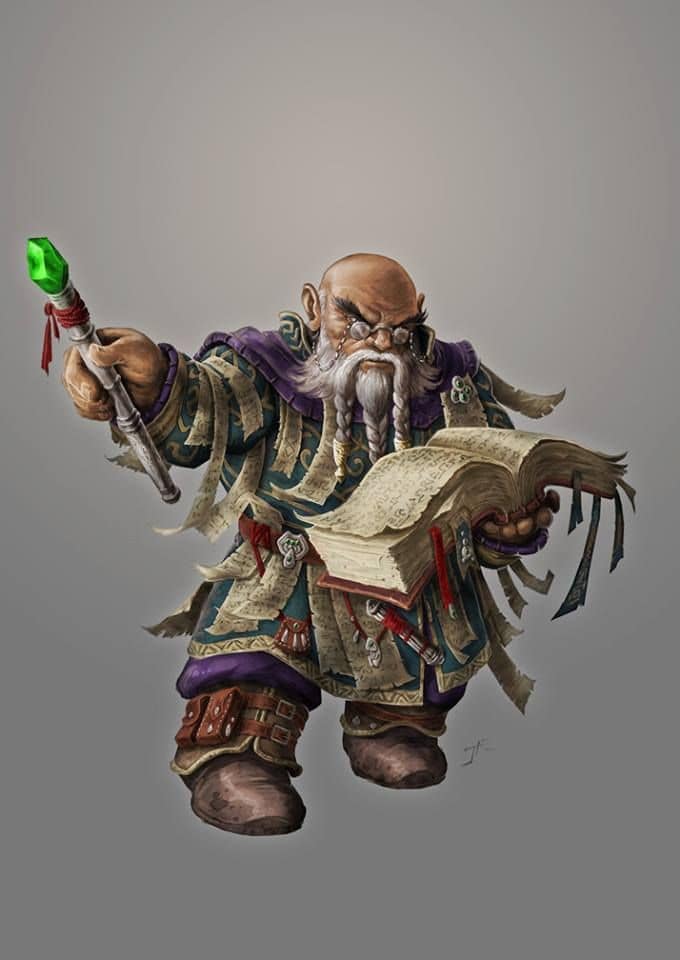
Unless you have a small party, the wizard is probably not the only D&D spell-caster in the group. It makes sense then to divide the functions of the spell-casters group so that there isn’t too much overlap.
One might be the Healer (cleric/paladin). One might be the Face (bard). One might be the damage dealer (warlock/sorcerer). Finally, one might be the Swiss Army Knife (wizard).
By Swiss Army Knife, I mean the caster with all of the utility spells. Whatever problem shows up, the Swiss Army Knife has the solution. This means that such a caster needs a wide variety of tools to use, rather than weapons.
My particular choices for cantrips and spells would ideally complement the other casters in the party. So, if I know who can do what in advance, that would help.
My wizard at 1st level would start out with 3 cantrips and 6 spells in his book, 2 of which could be prepared each day.
Let’s start with cantrips. Since cantrips can be cast at will without a short rest, the cantrips I choose are very important.
Even though my character’s spell-focus should be on utility spells, not combat spells, every wizard needs to have some combat spells and combat cantrips. My combat cantrip would be Ray of Frost rather than Fire Bolt because a lot of monsters are vulnerable to cold damage and resistant to fire damage.
Normally, I wouldn’t want to have more combat cantrips than 1, but since vulnerability is a big issue with wizards, I need some defensive spells/cantrips, and Blade Ward seems perfect because if things get bad, I could cast it every round as a bonus action.
The last of my three cantrips must be in the utility category if I’m going to retain my status as the party’s Swiss Army Knife. Since I have the smith’s tools proficiency anyway, I’m going to choose Mending. Used creatively, Mending can solve a lot of problems.
Moving onto the six 1st level spells in my book, my most important spell will be Find Familiar. Other than wizards, most casters can’t get that at 1st level.
Like my armor and my battleaxe, there is a financing issue due to the material components costing 10 GP: incense, charcoal, and herbs. If the DM won’t let me go on a side adventure and I have to choose between armor, a battleaxe, and a familiar, I would take the familiar.
If I’m on my first adventure being in a dungeon, my familiar would be a bat. With my bat’s echolocation capabilities, I could easily map out a good part of a dungeon level without exposing myself and the rest of the party to danger. Find Familiar Spell would turn my wizard into a drone pilot.

Sleep Spell will be the only damage-dealing spell in my book. Sleep Spell is the stun grenade of the D&D world, and for 1st level wizards, it is one of the most powerful damage dealers in the game, followed by Burning Hands Spell.
While Magic Missile Spell and other blaster spells might damage a single foe, Sleep Spell could wipe out a whole squad of goblins, orcs, etc.
Charm Person is something I would pick if my wizard were operating by himself. However, if there are any charisma-casters in the party, they are sure to have Charm Person. In that case, I would try to pick another spell they do not have. I might choose Grease instead, but it’s good to have Charm Person in my book.
One of the most practical utility spells for 1st level would be Tenser’s Floating Disk. Detect Magic Spell is also high on the utility spell list, as are Identify Spell and Comprehend Languages Spell.
So, with cantrips added, my spell list would look like what you see below. Most of my 1st level spells are ritual spells, so they don’t need to be prepared in advance. The boldfaced spells are the ones I would usually prepare before a day of adventuring.
Cantrips: Ray of Frost, Blade Ward, Mending
1st Level Spells: Sleep, Charm Person, Detect Magic, Identify, Tenser’s Floating Disk, Find Familiar
FAQs
Question: What about Mark of Warding Dwarves?
Answer: Mark of Warding dwarves do not appear in PHB and are part of the Eberron series. Their ASIs are +2 Constitution and +1 Intelligence. Consequently, they are a popular choice for dwarven wizards, but I prefer mountain dwarf wizards due to their natural armor proficiencies.
Question: What is the Difference Between a Side Adventure and the Main Adventure?
Answer: The main adventure is the challenging quest that your party undertakes. For DMs who don’t homebrew, this quest takes the form of a “module”. That module usually has some type of “dungeon”.
The dungeon might not literally be a prison, but it is usually some underground place with monsters, traps, and other challenges, the conquering of which is rewarded by treasure.
Good role-playing means that the adventure doesn’t begin at the entrance of the dungeon. Rather the adventure starts at some type of home base, like a town not too far from the dungeon, where the characters can eat, sleep, and buy weapons, armor, and equipment.
This home base often becomes the center of the campaign, which is the geographical/chronological/political setting in which all of the adventures take place.
A side adventure is usually in such a town or very close to the town. It is usually much shorter than a module. In Morgran’s case, this can involve using his gaming skills on some merchants to raise money for weapons and armor.
If he is not of good alignment, he can use his Sleep Spell on those merchants to rob them. A lot of the role-playing that happens in taverns, including the classic tavern brawl, could be classified as a side adventure.
Conclusion
As D&D evolves, so do the options. The stocky, bearded warrior with an axe to grind never gets old, but if you’d rather play pacifist Duergar/drow monk, have at it!
Even though D&D is a game with rules, the rules were designed for creativity. As long as your character isn’t overpowered or implausible within the imaginary reality that all players have agreed on with the DM, the multiverse is your oyster!
- Perform Bewitching 5e Guide - October 1, 2022
- Inspiring Leader 5e Guide - September 20, 2022
- Scrying 5e Guide - September 19, 2022


